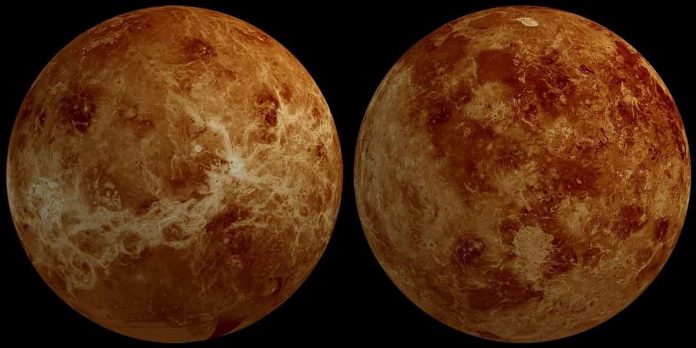According to a new study, the unusual behavior of sulfur in Venus’ atmosphere cannot be explained by an “aerial” form of extraterrestrial life. The University of Cambridge used a combination of biochemistry and atmospheric chemistry to test the “life in the clouds” hypothesis, which astronomers have debated for decades, and discovered that life cannot explain the composition of Venus’s atmosphere.
Any abundant life form is expected to leave chemical fingerprints on a planet’s atmosphere as it consumes food and expel waste. The Cambridge researchers, however, found no evidence of these fingerprints on Venus.
Even if Venus is lifeless, the researchers say their findings, published in the journal Nature Communications, could be useful for studying the atmospheres of similar planets throughout the galaxy, as well as the eventual detection of life beyond our solar system.
“We’ve spent the last two years trying to explain the strange sulphur chemistry we see in Venus clouds,” said co-author Dr. Paul Rimmer of Cambridge’s Department of Earth Sciences. “Because life is pretty good at strange chemistry, we’ve been investigating whether there’s a way to make life a potential explanation for what we see.”
The researchers studied the chemical reactions that are expected to occur given the known sources of chemical energy in Venus’s atmosphere using a combination of atmospheric and biochemical models.
“We looked at the sulfur-based ‘food’ available in the Venusian atmosphere—not it’s something you or I would want to eat, but it’s the main available energy source,” said Sean Jordan, the paper’s first author from Cambridge’s Institute of Astronomy. “If that food is consumed by life, we should see evidence of that in the form of specific chemicals lost and gained in the atmosphere.”
The models focused on a specific feature of Venus’s atmosphere: the abundance of sulphur dioxide (SO2). The majority of SO2 in the atmosphere on Earth comes from volcanic emissions. On Venus, high levels of SO2 are found lower in the clouds, but it is “sucked out” of the atmosphere at higher altitudes.
“If life exists, it must be influencing atmospheric chemistry,” says co-author Dr. Oliver Shorttle of Cambridge’s Department of Earth Sciences and Institute of Astronomy. “Could life be the reason for such drastic reductions in SO2 levels on Venus?”
Jordan’s models include a list of metabolic reactions that the life forms would perform in order to obtain their “food,” as well as waste by-products. The model was run by the researchers to see if the decrease in SO2 levels could be explained by these metabolic reactions.
They discovered that metabolic reactions can reduce SO2 levels, but only by producing other molecules in extremely large amounts that are not visible. The findings place a hard limit on the amount of life that could exist on Venus without shattering our understanding of how chemical reactions work in planetary atmospheres.
“If life is to blame for the SO2 levels we see on Venus, it would shatter everything we know about Venus’s atmospheric chemistry,” Jordan explained. “We wanted life to be a possible explanation, but when we ran the models, we discovered that it isn’t a viable option. But even if life isn’t to blame for what we see on Venus, there’s still a problem to be solved—a there’s lot of strange chemistry to investigate.”
Although there is no evidence of sulfur-eating life hiding in Venus’s clouds, the researchers believe their method of analyzing atmospheric signatures will be useful when JWST, the Hubble successor telescope, begins returning images of other planetary systems later this year. Some of the sulphur molecules in the current study are visible with JWST, so learning more about our neighbor’s chemical behaviour could help scientists figure out similar planets throughout the galaxy.
“To understand why some planets are alive, we must first understand why other planets are dead,” Shorttle explained. “If life somehow got into the Venusian clouds, it would completely change how we look for chemical signs of life on other planets.”
“Even if ‘our’ Venus is dead, Venus-like planets in other systems could host life,” said Rimmer, who is also affiliated with Cambridge’s Cavendish Laboratory. “We can apply what we’ve learned here to exoplanetary systems—this is only the beginning.”

